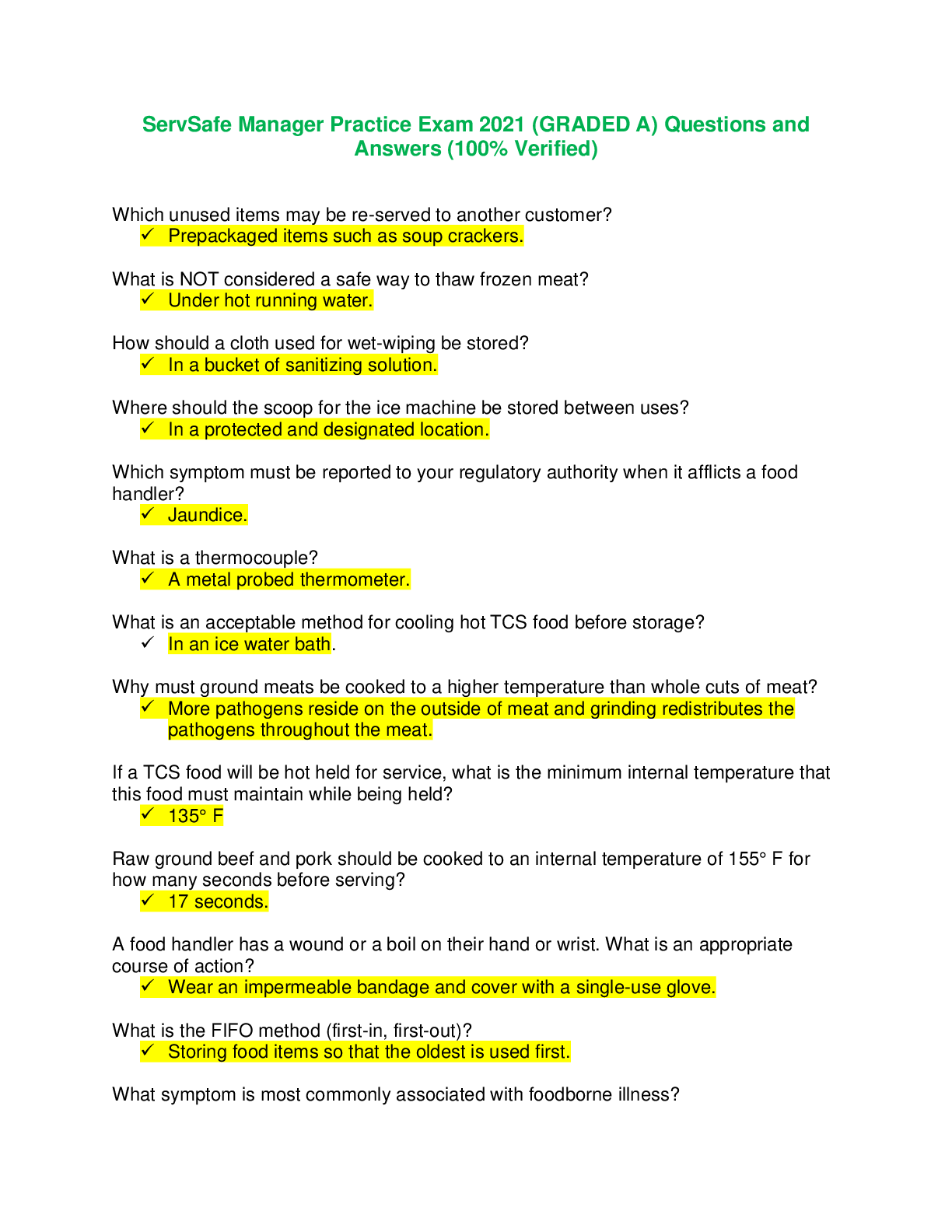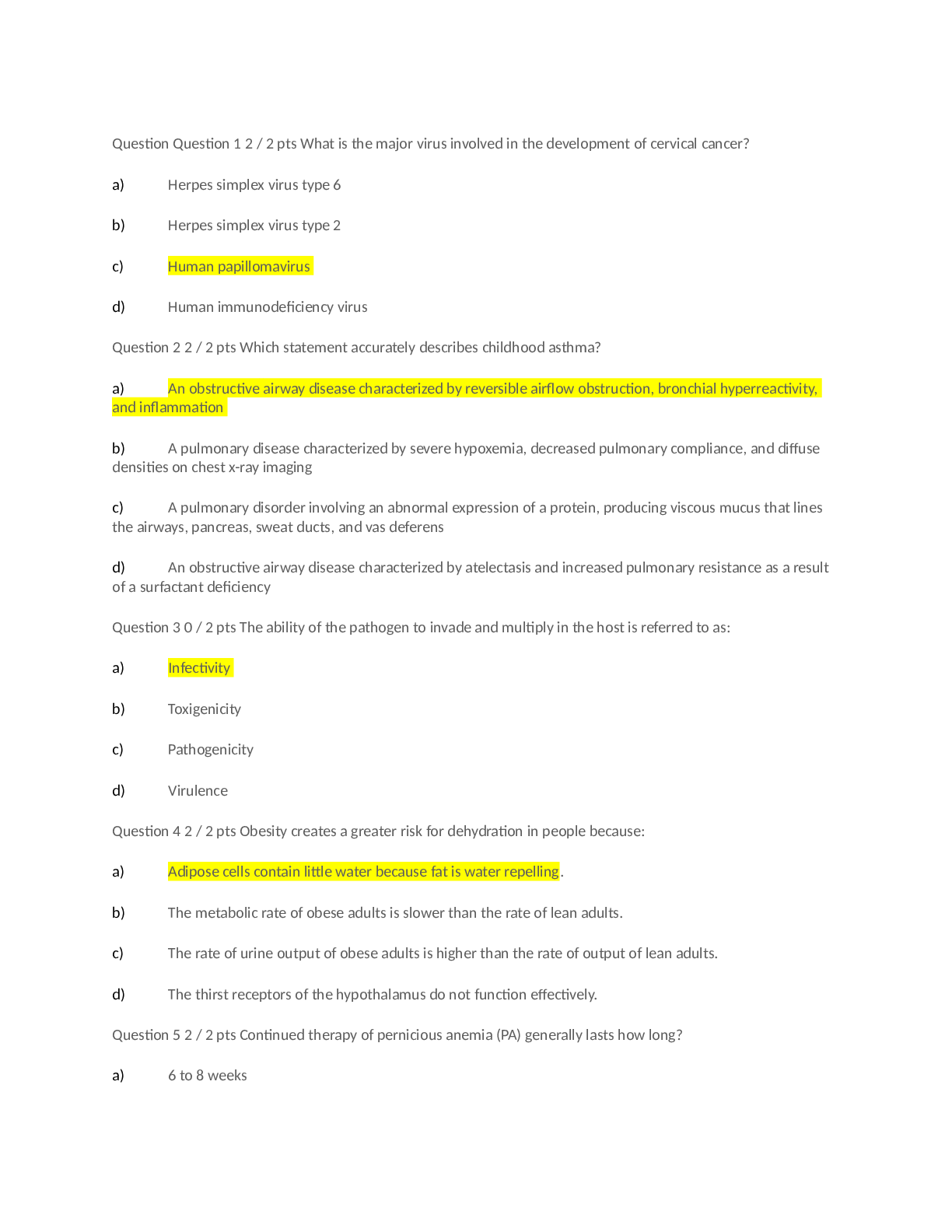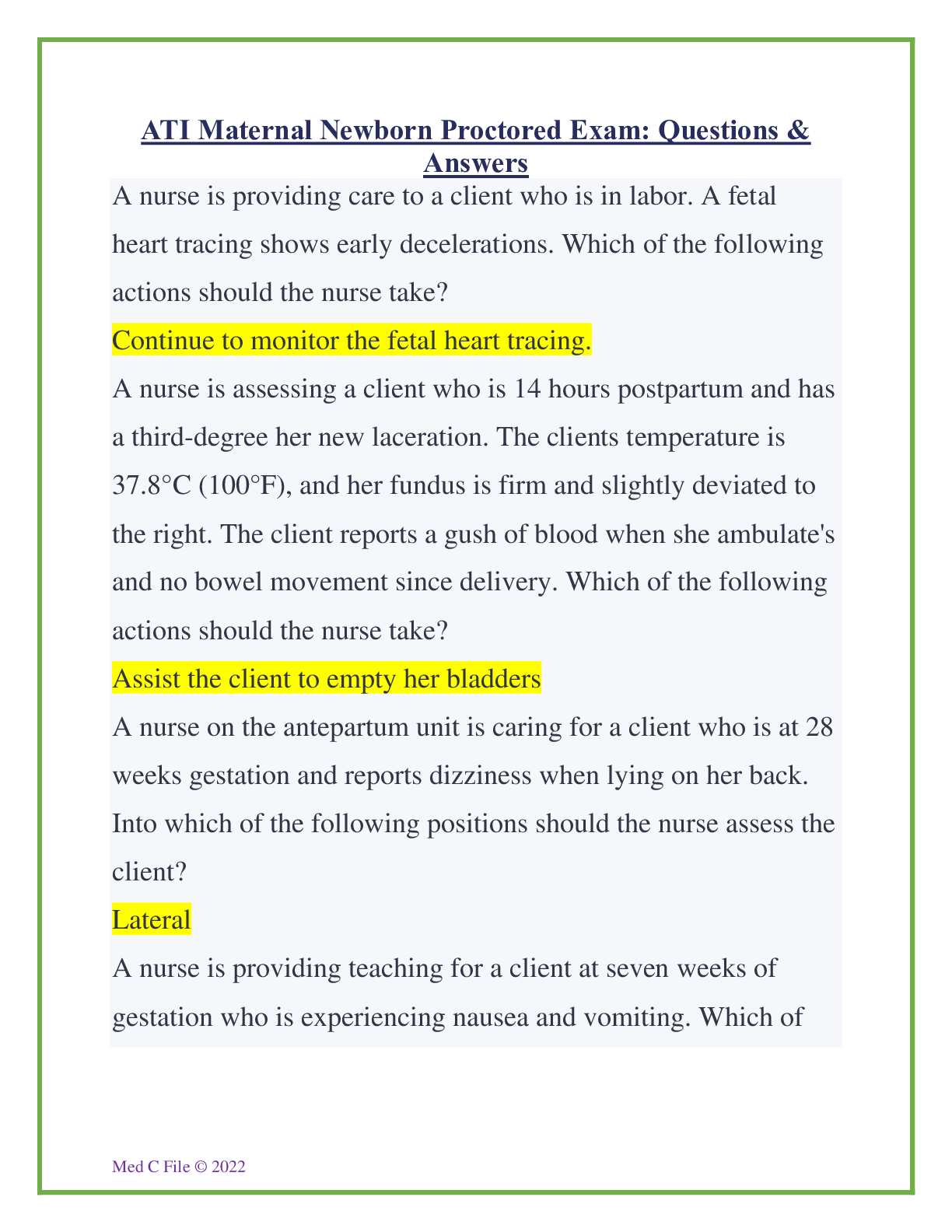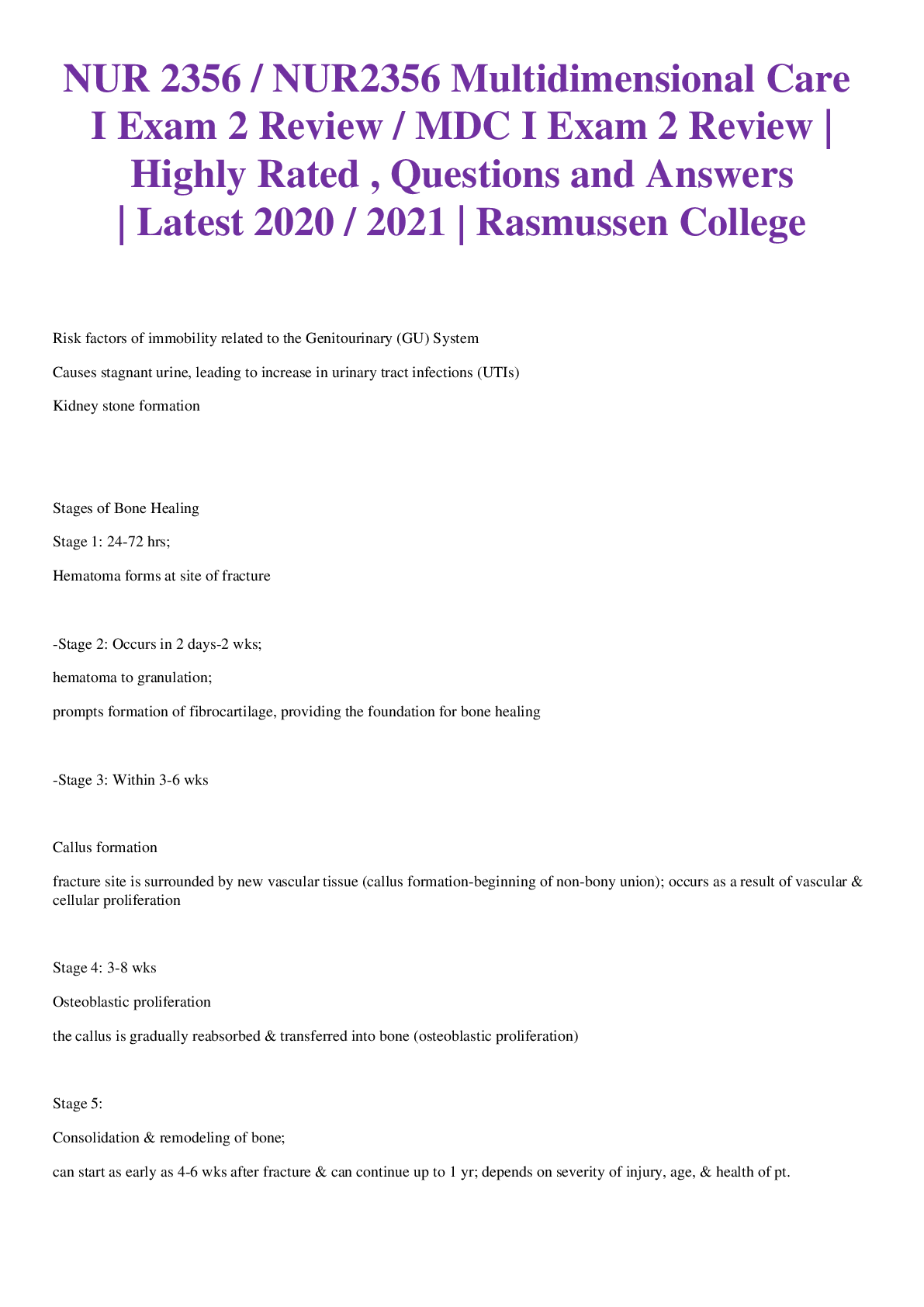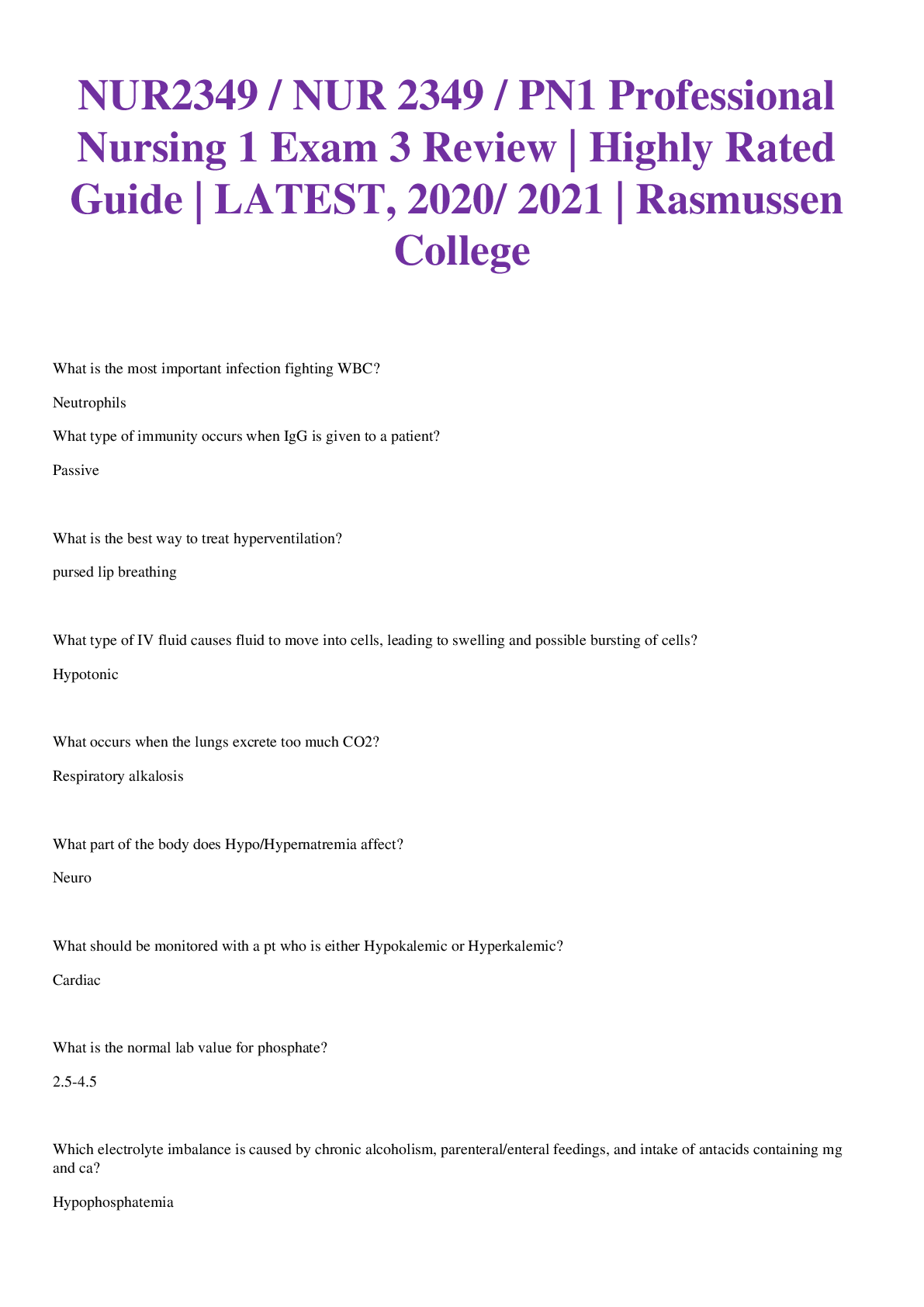*NURSING > EXAM > PSYC 290N Week 4 Adolescence Quiz (VOLUME 1) | Highly Rated Paper | Already GRADED A+ (All)
PSYC 290N Week 4 Adolescence Quiz (VOLUME 1) | Highly Rated Paper | Already GRADED A+
Document Content and Description Below
PSYC 290N Week 4 Adolescence Quiz Week 4 : Adolescence - Quiz 140054992 79202501 1 False false rldbqn=1 MultipleSections NavigateFreely False 0 Question 1. 1. (TCOs 7 and 9) Duri... ng a growth spurt, which is (are) likely to grow first? (Points : 2) The torso Arms and legs Hands and feet The brain 0 1422414056 MultipleChoice 2 Question 2. 2. (TCOs 7 and 9) Which hormone is responsible for normal brain development and overall rate of growth? (Points : 2) Adrenal androgen Thyroxine Testosterone Estrogen 0 1422414057 MultipleChoice 4 Question 3. 3. (TCOs 7 and 9) According to current research, which of the following accounts for the secular trend in development worldwide? (Points : 2) Better sex education Declines in teen sexual behavior Improvements in nutrition and healthcare Lack of proper prenatal care 0 1422414058 MultipleChoice 9 Question 4. 4. (TCOs 7 and 9) Which of the following groups is more likely to have a negative body image, get into trouble at school and with peers, and engage in delinquent behavior? (Points : 2) Late-maturing boys Early maturing boys Late-maturing girls Early maturing girls 0 1422414059 MultipleChoice 12 Question 5. 5. (TCOs 7 and 9) Which of the following groups is more likely to occupy leadership roles but also be at increased risk for alcohol or drug use? (Points : 2) Late-maturing girls Early maturing boys Late-maturing boys Early maturing girls 0 1422414060 MultipleChoice 13 Question 6. 6. (TCOs 7 and 9) Which of the following is one of the stages of crisis of teen pregnancy? (Points : 2) The escalation phase The denial phase The de-escalation phase The radical acceptance phase 0 1422414061 MultipleChoice 17 Question 7. 7. (TCOs 7 and 9) Which of the following comorbid conditions has been proposed by theorists as a possible explanation for the development of eating disorders in our society? (Points : 2) Obsessive compulsive personality disorder Obsessive compulsive disorder Schizophrenia Specific phobia 0 1422414062 MultipleChoice 20 Question 8. 8. (TCOs 7 and 9) What percentage of high school students in the United States have seriously considered suicide? (Points : 2) 1% 5% 15% 25% 0 1422414063 MultipleChoice 22 Question 9. 9. (TCOs 7 and 9) Charlene has achieved formal operational thought and is about to attempt Piaget's pendulum task. What can she do that she was unable to do when she was still in the concrete operations stage? (Points : 2) Formulate an approach to the task Try out varying combinations of height, weight, force, and length Measure the length of the string, the height of the pendulum, and the weight of the object Evaluate the effects of multiple factors in systematic, methodical fashion 0 1422414064 MultipleChoice 25 Question 10. 10. (TCOs 7 and 9) DeShaun wants to learn calculus so he can become an engineer. He is motivated by which type of goal? (Points : 2) Ability Metacognitive Hypothetical Task 0 1422414065 MultipleChoice 29 Question 11. 11. (TCOs 7 and 9) Which of the following is most consistent with the concept of a crisis as defined by James Marcia? (Points : 2) When Imani failed her calculus test, her parents grounded her for 2 weeks and imposed a requirement of 2 hours of supervised study every school night until the next exam. Since she was a child, Lila had planned to become a physician when she grew up. Recently, however, she has become very interested in physics, and now she is evaluating related career options, such as engineering. Torrential rains in the Midwest caused major flooding, and thousands of people were displaced from their homes and lost their possessions and livelihoods. For the past 2 years, Juan has had thoughts of suicide, and he was recently diagnosed with depressive disorder. 0 1422414066 MultipleChoice 33 Question 12. 12. (TCOs 7 and 9) Juanita is planning to go to nursing school because her parents work at the local clinic. She has never even considered other options. Juanita is in which stage of identity development, according to James Marcia? (Points : 2) Achievement Foreclosure Moratorium Diffusion 0 1422414067 MultipleChoice 34 Question 13. 13. (TCOs 7 and 9) Which of the following might be an advantage of cultures that have clearly identified rites of passage into adulthood? (Points : 2) Teenagers are able to establish a clear transition from childhood to adulthood. Teenagers are able to take on careers earlier. Teenagers are encouraged to make career decisions for themselves. Teenagers are can more easily resolve the crisis of identity confusion. 0 1422414068 MultipleChoice 37 Question 14. 14. (TCOs 7 and 9) Maria’s father is from Mexico and her mother is Caucasian and was born in North Dakota. Maria's father expects Maria to listen to traditional Mexican music, dress conservatively, and attend mass every Sunday. This would be an example of which of the following according to Root's research? (Points : 2) Biracial conflict Establishing a biracial identity Hazing and proving authenticity Establishing peer acceptance 0 1422414069 MultipleChoice 42 Question 15. 15. (TCOs 7 and 9) The point at which an adolescent minority individual becomes aware of how she is perceived by the majority culture is part of which stage of Phinney's theory of ethnic identity? (Points : 2) Ethnic identity search Unexamined ethnic identity Ethnic identity clarification Ethnic identity achievement 0 1422414070 MultipleChoice 43 Question 16. 16. (TCOs 7 and 9) Mr. Smith pays his income taxes and obeys the posted speed limits because "that is the law," he says. Mr. Smith is most likely reasoning at which stage of moral development? (Points : 2) Punishment and obedience orientation Preconventional morality Postconventional morality Social system and conscience 0 1422414071 MultipleChoice 48 Question 17. 17. (TCOs 7 and 9) Which of the following characteristics is both a cause and a consequence of moral development according to Nancy Eisenberg? (Points : 2) Justice Wisdom Equality Empathy 0 1422414072 MultipleChoice 51 Question 18. 18. (TCOs 7 and 9) If you believe that there are distinct differences in the way that boys and girls perceive moral dilemmas, which theorist would you most likely support? (Points : 2) Lawrence Kohlberg Carol Gilligan Samuel Elkind Nancy Eisenberg 0 1422414073 MultipleChoice 52 Question 19. 19. (TCOs 7 and 9) Which of the following best summarizes the importance of parental- teen relationships across cultures? (Points : 2) The consistency and quality of peer attachments seem to be more important to most teens than the strength of parental attachments. Teens who are too attached to their parents tend to have poor peer relationships. The consistency and quality of the parental attachment seem to be more important to most teens than the strength of peer attachments. Peer relationships always take precedence over parental relationships during adolescence. 0 1422414074 MultipleChoice 55 Question 20. 20. (TCOs 7 and 9) Which statement most accurately describes the progression of peer group structures through adolescence? (Points : 2) Same-sex cliques combine into crowds that evolve into heterosexual cliques and associations of couples. Crowds dissolve into cliques that reorganize into heterosexual pairs. Reputation-based groups become identity prototypes that will become either cliques or crowds. Peers separate from cliques to form broader groups based on interests. 0 1422414075 MultipleChoice 58 Question 21. 21. (TCOs 7 and 9) Describe adolescent romantic relationships. By what age do teens have a sense of what it means to be in love? What are some gender differences in these perceptions? Different societies have different views on when adolescents begin romantic relationships. There was a study that looked at the difference between Chinese and Canadian teens. In this study, they concluded that Chinese teens felt more of an attachment to their parents, whereas Canadian teens felt a close relationship with friends (Boyd, 316). This shows that the romantic relationships tend to develop in later years of adolescence. For teenagers, homosexual and heterosexual teens tend to develop in different paths. For heterosexual teens, it is said that by the age of 12, or 13, most have a sense of what it means to be in love. They use this understanding as a base for their romantic relationships. If the love isn't there, they are seen to end the relationship and move on to find other love. This is the beginning foundation for what adults use. In homosexual teens, romantic relationships for at an earlier age, around 11 or 12. It is interesting because homosexual teens are quite opposite in how they express themselves. Where heterosexual girls act earlier, it is opposite that homosexual boys will act on their attraction at an earlier age, but not be as confident about their sexual identity. Whereas, homosexual girls, will be more open and commit to their orientation, but may not act on it as quickly as a homosexual boy (Boyd 316). Whether you agree with Freud who thought that adolescents go through a genital stage where sexual maturity is reached; or Erikson, who thought that adolescents was about role confusion and identity. We can all agree that adolescence is the most important time for a child. It is where teens not only learn about who they are, but experimentation can also occur not just with sexuality. Teens are learning so much in this time that can help them become the person they will be as an adult, whether that be personal relationships, or career paths. [Show More]
Last updated: 2 years ago
Preview 1 out of 9 pages
.png)
Buy this document to get the full access instantly
Instant Download Access after purchase
Buy NowInstant download
We Accept:

Reviews( 0 )
$13.50
Can't find what you want? Try our AI powered Search
Document information
Connected school, study & course
About the document
Uploaded On
Apr 19, 2022
Number of pages
9
Written in
Additional information
This document has been written for:
Uploaded
Apr 19, 2022
Downloads
0
Views
95
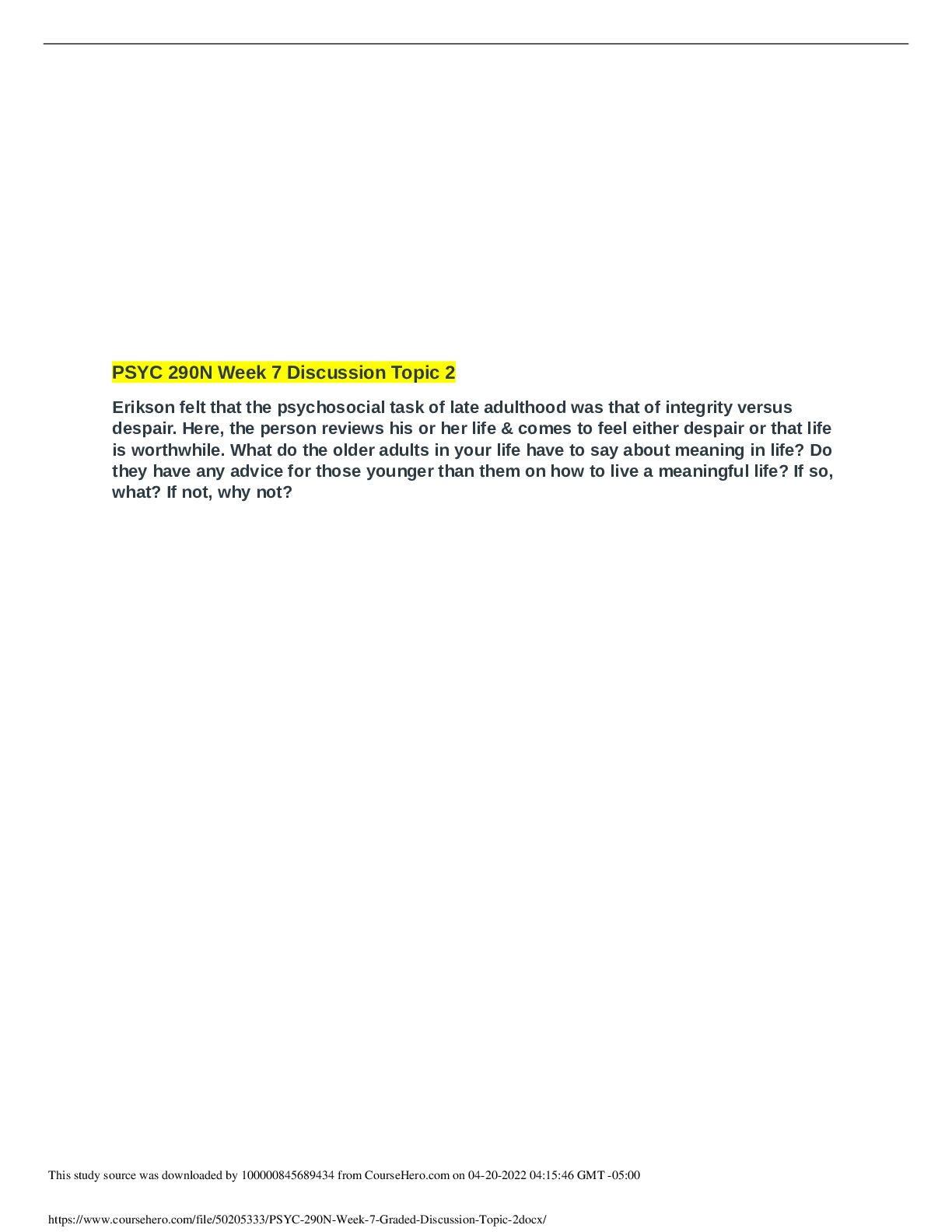

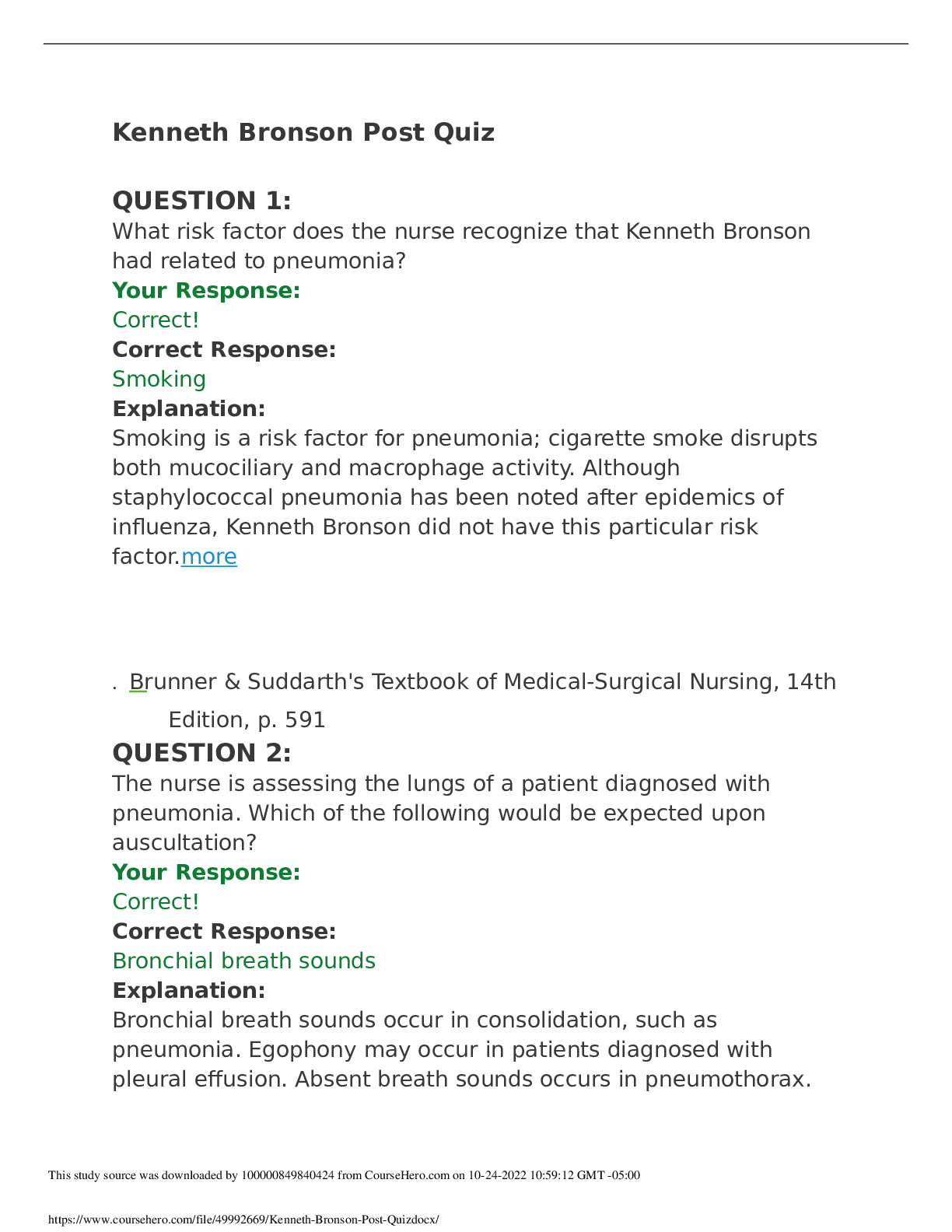



 Questions and Answers 100% VERIFIED.png)
 Questions and Answers 100% correct Solutions.png)



